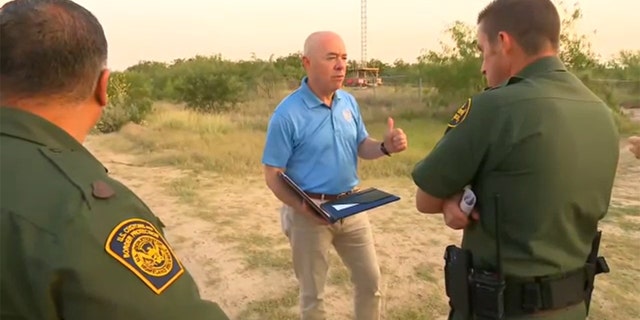
NEWYou can now listen to Fox News articles!
Homeland Security Secretary Alejandro Mayorkas has repeatedly claimed that illegal immigrants whose asylum claims fail will be removed “promptly” from the United States – but former Immigration and Customs Enforcement officials are pushing back, saying that there is little chance of that happening given the mass release of illegal immigrants into the U.S. and the current policies of the administration.
“If they’re on the border, and they don’t claim asylum they can be removed right there, but if they claim asylum, and they are released into the United States, they are not promptly removed,” former acting Immigration and Customs Enforcement (ICE) Director Thomas Homan told Fox News Digital in an interview this month.
In media appearances and in front of multiple congressional hearings, Mayorkas has repeated his claims about what happens to migrants at the southern border.
“They are either expelled under the Title 42 of the [Centers for Disease Control], or they are placed into immigration enforcement proceedings. They make their claims under the law. If those claims don’t prevail, they are promptly removed from the United States,” he said on “Fox News Sunday.”
FEDERAL JUDGE EXPECTED TO RULE ON TITLE 42 LAWSUIT WITHIN DAYS AS BORDER CRISIS ROLLS ON
On Tuesday he made a similar claim about migrants being removed, but omitted the word “promptly.”
“They are not merely released into the United States but rather they are placed into immigration enforcement proceedings and that is where they make their claims for relief under the laws of this country, make a claim for asylum,” he told reporters. “If they qualify then they’ve established a basis to remain, if they dont’ they are removed, and they have an enforcement record on the books.”
Migrants who are encountered and pass an initial asylum screening are released into the United States, often with either a Notice to Report at an ICE facility, or with a Notice to Appear at a court for their immigration hearings. It is through that court process that they make their claim for asylum.

Homeland Security Secretary Alejandro Mayorkas visited the U.S. southern border, Tuesday, May 17, 2022. (Pool video)
The immigration hearing process that Mayorkas describes as “immigration enforcement proceedings” takes well over five years before a deportation order is given (Mayorkas said this week it can take between six and eight years), during which migrants are not detained. There are about 3.5 million migrants currently in this status, known as the “non-detained docket.” A small number of those will be enrolled in “Alternatives to Detention” for a part of their proceedings, where they will have to check in via a phone call or a smartphone app or in some cases have an ankle bracelet. Currently, there are around 220,000 migrants enrolled in ATD.
The Washington Post published a fact check of Mayorkas’ comments about migrants being “promptly removed,” giving him “Three Pinnochios” and noted the five-year-plus wait time — noting that that isn’t promptly at all. However, DHS has said that the “prompt” removal to which Mayorkas is referring to, means what happens when migrants are found not to have a valid claim.
“As Secretary Mayorkas stated, ‘If those claims don’t prevail, they are promptly removed from the United States.’ The data shows that to be true,” DHS said in a statement to Fox News Digital.
It cited statistics showing that 86% of those encountered at the border in FY2021 “who did not make successful claims [for relief] were repatriated by the end of [Calendar Year 2021.]” However, this would refer to those removed under processes at the border like expedited removal, not those who did pass the initial asylum screening and were released into the country for immigration court hearings – which typically take years.
In terms of that non-detained docket, DHS has said it acknowledges that the current court process is too long a timeframe, which is why it is implementing a new asylum rule to reduce that time to months by transferring cases from immigration judges to U.S. Citizenship and Immigration Services officials. Republicans have objected to that rule, saying it was lower the bar for entry even further and make it easier for asylum claims to get approved. But on Tuesday, Mayorkas said it will allow those removals to happen “promptly.”
“What that means is if one qualifies then that determination is made more rapidly than it has been in the past, and if one does not qualify then that determination is made more rapidly than in the past, and a removal will promptly follow,” he said.
In terms of those currently who are released and who through the full immigration proceedings, very few are eventually granted any form of asylum. The FY 2020 immigration lifecycle report found that, of cases resolved, 86 percent resulted in an order of removal and 14 percent led to relief. But that doesn’t necessarily mean they are deported.
ICE officials who served during the Trump administration, were extremely skeptical of Mayorkas’ claim that those who are released into the interior for their hearings would be quickly deported when ordered removed. Former acting ICE chief Thomas Homan said it was “extremely difficult” to remove illegal immigrants when he was in office, even with an administration that promoted expelling those in the country illegally.
“95% of everybody we removed, we removed from a [detention] bed,” he said.
Officials note that those who have a final order of removal are often not willing to leave the country by themselves, and will often disappear, leaving ICE to track them down. Additionally, many Democratic cities and states have “sanctuary” policies which limits cooperation with ICE.
“In the practical sense it’s hard to find them, because you’re going off very scant information,” former Chief of Border Patrol and retired acting ICE Director Ronald Vitiello said in an interview.
Vitiello said that during his time in office, ICE initiated a project where the agency sent out officers to track down 2,500 illegal immigrants in 10 large cities across the country who had been ordered removed “in absentia.” Vitiello said that after about a month, they caught just approximately 30 people.
Like Homan, he said that the key difference on deportations was whether or not the illegal immigrant was in detention or free in the country, even if enrolled in Alternatives to Detention.
“It’s always difficult to find them, it’s much more difficult to find them when they’re out and about versus in detention,” he said.
Additionally, when illegal immigrants have been in the country for years, it can be harder to remove them due to ties they already have in the country that can delay their removal.
“There’s a logistical part of it because they may have children born here, they may be caring for an elderly relative, they may have someone in their home who is a special needs person, so it becomes much more difficult,” he said.
He also said that new ICE enforcement priorities, which restricts priorities to recent border crossers (who arrived since Nov. 2020), aggravated felons and national security threats, make the job even harder for ICE officers.
“You can’t approach these people unless they fit into these discrete categories, so this administration made it much harder,” he said.
Additionally, Homan pointed to the restrictions that bar ICE officers from conducting worksite enforcement raids, as well as barring ICE operations near schools, churches and other areas deemed sensitive.
“When we did worksite enforcement raids, we’d find not only employees with final order of removals and they were fugitive, we’d find illegal aliens with criminal records, but ICE can’t go on worksites anymore, which is another magnet the cartels are using,” he said.
Jon Feere, a former ICE chief of staff, said that if the Biden administration did wish to remove illegal immigrants whose cases failed, they would ramp up detention — but said that ICE under Biden is using less detention than the Trump administration.
ILLEGAL IMMIGRANT WHO ALLEGEDLY DREW SWASTIKAS IN DC UNION STATION WON’T BE DEPORTED: ICE
“It’s a matter of resources, if you increase the supply of the number of people who need to be deported you’re going to have a commensurate increase in resources and this takes the form of deportation officers and detention beds,” he said, noting that it was also a responsibility for Congress to increase that funding for ICE as well.
He also said that the Biden administration was not pushing countries to take back their illegal immigrants in the same way the Trump administration was — which imposed visa sanctions on countries that refused to take back their nationals.
“If this administration isn’t even attempting to force countries to take their people back with visa sanctions, then it’s not going to happen for a significant number of people and that’s just one example.”
CLICK HERE TO GET THE FOX NEWS APP
Meanwhile, deportations have plummeted under the Biden administration. In FY 2021, just 59,011 were deported, down from 185,884 in FY 2020 and 267,258 in FY 2019.
Mayorkas himself has previously touted how the administration has “fundamentally changed” immigration enforcement, and that now merely being an illegal immigrant is not in and of itself a deportable offense.
“For the first time ever, our policy explicitly states that a non-citizen’s unlawful presence in the United States will not, by itself, be a basis for the initiation of an enforcement action,” he said in January.







